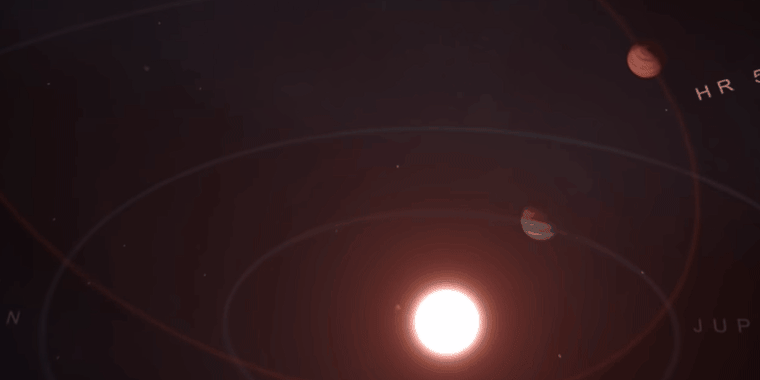Astronomers have discovered a giant planet whose extreme orbit makes it unlike anything they’ve ever seen.
Dubbed HR 5183 b, the exoplanet is at least three times as massive as Jupiter, and it takes a long, looping path around a star that lies about 100 light-years away in the constellation Virgo. If the exoplanet were in our own solar system — in which Earth and the other planets move around the sun in nearly circular orbits — its extremely elliptical orbit would take it from beyond Neptune to within the orbit of Jupiter (see video below).
The discovery shows that "our universe is full of lots of weird solar systems totally unlike our own," Sarah Blunt, a graduate student at the California Institute of Technology in Pasadena, and one of the scientists behind the discovery, said in an email. "It seems like every time we think we've found the weirdest solar system, something else totally strange is discovered."
Blunt, the lead author of a paper about the discovery, called the exoplanet "a wacky object" and likened its movements around its host star, HR 5183, to "whiplash," speeding up as it swoops near the star's intense gravitation, slowing as it moves away and then beginning the cycle all over again.
She said other exoplanets with highly elliptical, or eccentric, orbits have been observed but HR 5183 b is the only one known to orbit its host star at such extreme distances.
"Something must have interacted with the planet to pump up its eccentricity," she said in the email, adding that one possible scenario was that HR 5183 b once had a neighboring planet whose gravitation deflected the exoplanet. But it could have been a star that deflected the exoplanet — or "something we haven't thought of yet."
The astronomers didn't observe HR 5183 b directly but inferred its size and orbit by observing tiny "wobbles" in light from its host star caused by the changing gravitational pull of an orbiting planet (a technique known as the radial velocity method). The data that led to the discovery came from observations made at the Lick Observatory in Hamilton, California; the Keck Observatory in Waimea on the Island of Hawaii; and the McDonald Observatory in Fort Davis, Texas.
Brendan Bowler, a University of Texas astronomer who wasn't involved in the new research, hailed the discovery, saying the exoplanet's extreme orbit around its star "is telling us something about the outskirts of planetary systems." He called the discovery "a stepping stone" on the path toward "understanding how planets form and to understand their statistical properties."
The astronomers behind the discovery aren't done yet with HR 5183 b. Blunt said it might be possible to determine the exoplanet's absolute mass using data from the European Space Agency's Gaia space observatory, which aims to produce a detailed census of about 1 billion stars. In addition, she said, astronomers might simulate the formation of HR 5183 b to learn more about the conditions that led to such an exoplanet.
"There's a lot of next steps for this planet!" she said.
Want more stories about space?
- Super-detailed black hole simulations solved a long-standing mystery
- Life on Mars? NASA's Curiosity rover detects 'unusually high' levels of methane
- Apollo moon rocks may unlock more secrets about our solar system
Sign up for the MACH newsletter and follow NBC News MACH on Twitter and Facebook and Instagram.
